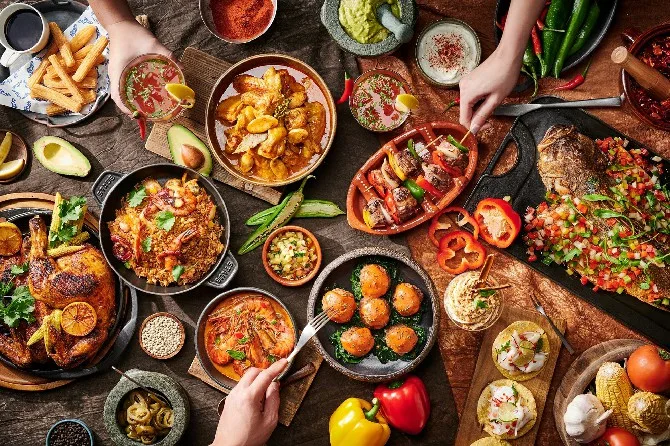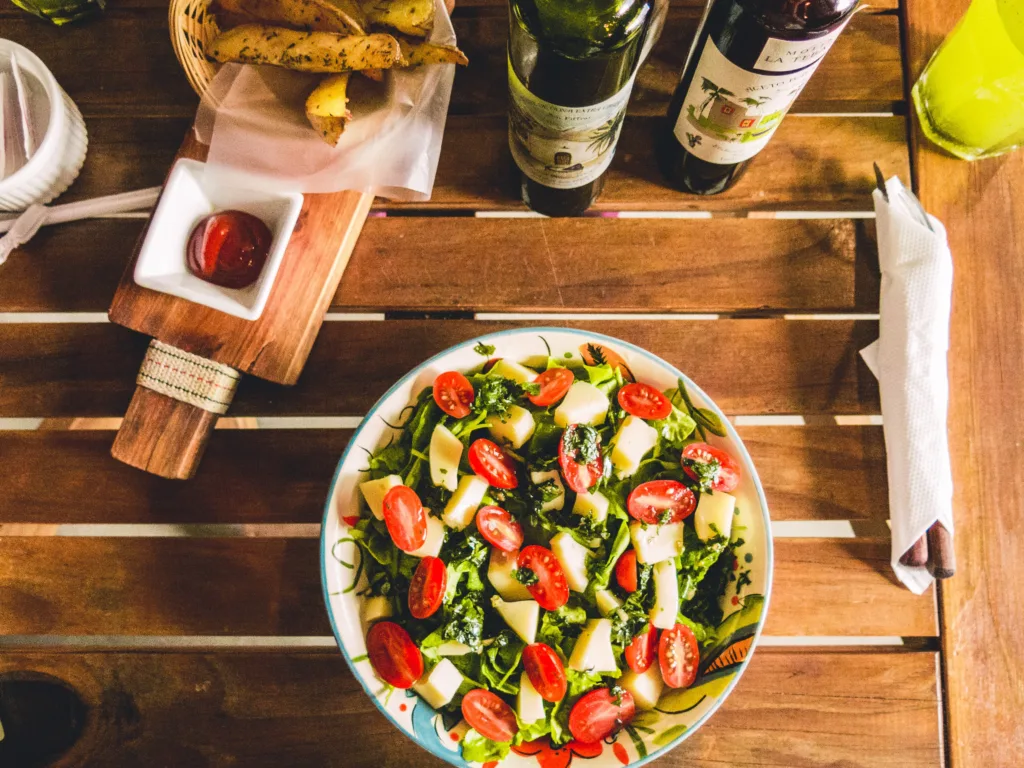Food is so much more than just fuel for our bodies. It is connection. It is community. It allows us to explore new cultures, discover exciting flavors and celebrate traditions from around the globe. Meals lovingly prepared bring family and friends together. The aromas, colors and textures of dishes we grow up with imprint on our memories and become intrinsically tied to culture and home.
Yes, food provides sustenance. But it also provides joy. It sparks creativity in the kitchen and contentment around the table. Unfortunately, rates of obesity, heart disease and diabetes remind us that the modern diet is dangerously out of balance. We have access to endless processed convenience foods while losing sight of the traditional whole food ways of eating that supported health for generations.
But here’s the beauty – we absolutely can find excitement and satisfaction in food while improving our health, including reaching a healthy weight. It simply starts with a spirit of exploration. By learning to creatively navigate and adapt recipes from various cuisine traditions, we can discover amazing new flavor combinations that not only satisfy our taste buds but also help us lose weight in a sustainable, enjoyable way.
In this post, we’ll break down some of the core principles for healthy, moderate weight loss. We’ll then take a delicious tour through how we can incorporate dishes from Mediterranean, Asian and Latin American cuisines into a successful weight loss plan. Are you ready? Let’s do this!

Weight Loss 101: Back to Balance
Before jumping full force into global cuisine styles, it helps to review some basic tenets of safe, sustainable weight loss. Crash diets that severely restrict calories often backfire by causing rebound overeating and weight gain over time. They are difficult to stick to long-term. A more balanced, moderate approach is ideal.
The basics of weight loss science boil down to this: we need to tip the scales to expend slightly more calories than we consume each day. A reasonable daily deficit of about 500 calories can lead to about 1-2 pounds of weight loss per week, which is a safe recommendation. This calorie balance can be achieved through a combination of eating a little less and moving our bodies a little more. No need for drastic measures – small changes add up!
But weight loss isn’t just about calories in and calories out. It’s also vital that the calories we do consume come from nutrient-dense whole foods that nourish the body. A diet emphasizing minimally processed vegetables, fruits, lean proteins, legumes, nuts/seeds and whole grains provides essential vitamins, minerals, fiber and beneficial plant compounds to support optimal health. Refined sugars, starchy carbs and saturated fats are limited.
Portion control is also key, as even healthy foods can add excess calories if we overdo servings. In general, balanced meals should contain:
- 1⁄4 plate lean protein about the size of your palm – fish, chicken, eggs, tofu etc.
- 1⁄4 plate whole grains like brown rice, quinoa, buckwheat – provide steady energy and fiber
- 1⁄2 plate non-starchy vegetables – pack nutrients without spiking blood sugar
- Optional side salad with vinaigrette dressing
- One piece of fresh fruit for dessert – mother nature’s candy!
This template allows for nutritious, satisfying meals full of antioxidants and phytochemicals that support the body while promoting weight loss through appropriate portions. Now, let’s explore how we can bring this balanced plate to life through the fantastic flavors of cuisines from around the globe!

Mediterranean Cuisine: Fresh, Life-Giving Ingredients
Transitioning to a Mediterranean-style pattern of eating is one of the most effective and sustainable dietary approaches for weight loss and overall health. Traditional dishes from countries like Greece, Italy, Spain and the Middle East rely on simple, minimally processed ingredients like olive oil, fish, beans, yogurt, herbs, tomatoes, whole grains and copious amounts of vegetables.
Red meat is enjoyed only in smaller portions a few times a month, rather than eating large servings daily. Meals are built around nutrient-dense whole foods layered with flavor from garlic, onions, lemons, peppers and herbs like oregano, basil and parsley. Vegetables like eggplant, spinach, zucchini, tomatoes and artichokes take center stage, often drizzled with olive oil and baked, grilled or sautéed to perfection. Fish like salmon, tuna and halibut provide lean protein and heart-healthy omega-3 fatty acids.
Some tips for savoring Mediterranean flavors while losing weight:
- Marinate chicken or fish fillets in lemon juice, garlic, oregano and olive oil – grill until cooked through and tender.
- Roast a rainbow of vegetables tossed in a bit of olive oil, lemon, fresh herbs – serve as a side or over whole grain pasta.
- Make satisfying grain-based salads with nutty farro, quinoa or brown rice, chopped veggies, beans, feta cheese, fresh herbs.
- Top Greek yogurt or oatmeal with antioxidant-rich berries and chopped nuts.
- Snack on a handful of unsalted nuts, carrots with hummus or hard boiled eggs with a dash of paprika.
- Sauté spinach with garlic and lemon for a quick side. Toss with chickpeas for added protein.
With its reliance on whole, minimally processed foods, Mediterranean cuisine provides incredible flavor in dishes naturally geared toward supporting weight loss and health.
Asian Cuisine: Light, Nutritious Meals
Asian cuisines like Chinese, Japanese, Korean, Thai and Vietnamese cooking offer numerous dishes perfect for those seeking to drop pounds. Meals are centered around rice or noodles accented by colorful vegetables, lean proteins, and seasoned with aromatic ingredients like ginger, garlic, chilies and soy sauce.
While traditional Asian eating patterns may use more sodium and oil than recommended for weight loss, there are easy ways to enjoy big flavor with fewer calories at home. The key is loading up on low-calorie vegetables and swapping out higher-calorie white rice for riced cauliflower or shirataki noodle alternatives.
Start with a base of riced cauliflower or shirataki noodles, then pile on stir-fried, steamed or raw veggies like bok choy, bell peppers, mushrooms, snap peas and bean sprouts. Add a protein like baked tofu, grilled shrimp or poached chicken. Build flavor from fresh herbs like basil, cilantro, sliced scallions and reduced sodium tamari or soy sauce. Garnish with a sprinkle of chopped peanuts or sesame seeds.
Skip heavy creamy sauces, sweetened dishes, breaded/fried appetizers and high-sodium soups when dining out. Enjoy broth-based soups with veggies and lean protein. Choose steamed, grilled or stir-fried entrees flavored with garlic, ginger and chili pepper. Fill up on steamed vegetables, salads and fresh summer rolls. Jasmine green or oolong tea are zero calorie beverage options.
Tips for lightened Asian-inspired meals:
- Try riced cauliflower or shirataki noodles instead of white rice to cut carbs.
- Load up stir-fries with lots of colorful veggies for bulk and nutrients.
- Steam, grill or poach chicken, tofu or fish – skip heavy breading and frying.
- Flavor foods with fresh herbs, garlic, ginger, scallions, chili pepper, reduced-sodium soy sauce.
- Enjoy miso soup packed with mushrooms, baby bok choy, scallions and soft tofu.
- Snack on edamame beans sprinkled with a pinch of sea salt for a savory, plant-based protein.
With a few easy substitutions, Asian cuisine offers incredibly nutritious, delicious options for supporting weight loss goals.

Latin Cuisine: Fresh, Vibrant Flavors
From Mexico down to Brazil and Argentina, Latin cuisine is bursting with sunny, satisfying flavors perfect for spicing up a weight loss plan. Dishes call on fresh ingredients like peppers, onions, tomatoes, beans, tropical fruits, and leaner proteins like fish, chicken and beef.
Traditional Latin cooking does incorporate more oils, cheese and fatty pork than the previous two cuisines. But there are simple ways to enjoy these vibrant flavors while cutting calories and slimming down. The focus is fresh, fresh, fresh when it comes to produce and flavor.
Build meals around plant-based dishes like black bean tacos or enchiladas stuffed with grilled veggies, avocado and salsa. Enjoy fajitas with chicken or shrimp, peppers and onions with a sprinkling of cheese and guacamole. For a light salad, combine sliced jicama, mango, chili powder and squeeze of lime.
When choosing proteins, opt for leaner options like grilled fish, chicken or 90/10 ground turkey instead of fatty pork or red meat. Baking, grilling or stewing meats in tomato-based sauces limits calories compared to frying. Enjoy brown rice, quinoa or roasted vegetables on the side for filling fiber. Skip chips, sugary doughy desserts and soda and enjoy fresh fruit waters, gazpacho soup and sliced mango sprinkled with chili powder instead.
Tips for lighter Latin-inspired meals:
- Focus on plant-based entrees with beans, vegetables, greens or salads
- Choose lean proteins like grilled chicken, fish and 90/10 ground turkey
- Load up on fresh produce – tomatoes, avocado, tropical fruits, herbs
- Incorporate healthy sides like brown rice, beans, grilled veggies
- Skip sugary drinks – enjoy agua fresca, light gazpacho, juices, lime water
With a few simple tweaks, Latin cuisine can absolutely be part of delicious, healthier eating geared toward weight loss success.

Final Thoughts: Healthy Eating As Exploration
What an amazing culinary journey through the flavors of Mediterranean, Asian and Latin cuisines! Each offers its own regional diversity, ingredients and cooking techniques that highlight the best of food – bringing people together in the kitchen and around the table to share in traditions, creativity and joy.
The fantastic news is that we absolutely can adapt our favorite global cuisine dishes and still reach health goals like achieving a healthier weight. At the core, focusing on whole foods like vegetables, fruits, lean proteins, legumes and whole grains supports sustainable weight loss across all cuisines. Herbs, spices, aromatics and plant-based oils allow us to add incredible flavor without excess calories.
As you incorporate new dishes from around the world, remember to practice balance, variety and moderation. Savor higher calorie cultural foods on occasion but emphasize lighter everyday meals. Exploring nutrition and fitness as the gateway to overall wellness allows us to reconnect with the simple joy of food. We can rediscover how real, minimally processed ingredients form the foundation of cuisines that have supported human health across centuries and continents. Getting back to these traditional whole food ways of eating helps us look and feel our best while delighting in nature’s delicious bounty.
Here’s to many happy travels both around the globe and on your own health journey! Feel free to explore more of my articles on healthy cooking, nutrition and wellness. For fresh recipe ideas and tips each week, subscribe to my newsletter using the box below.
Thank you for reading this post, don't forget to subscribe to our free newsletter
!
